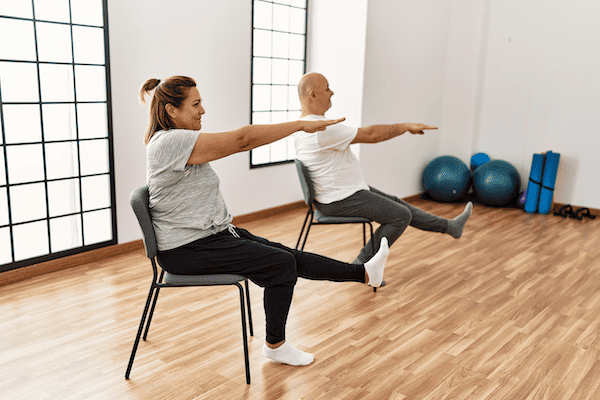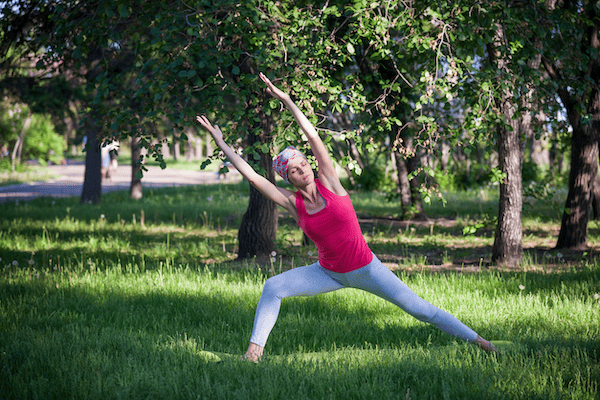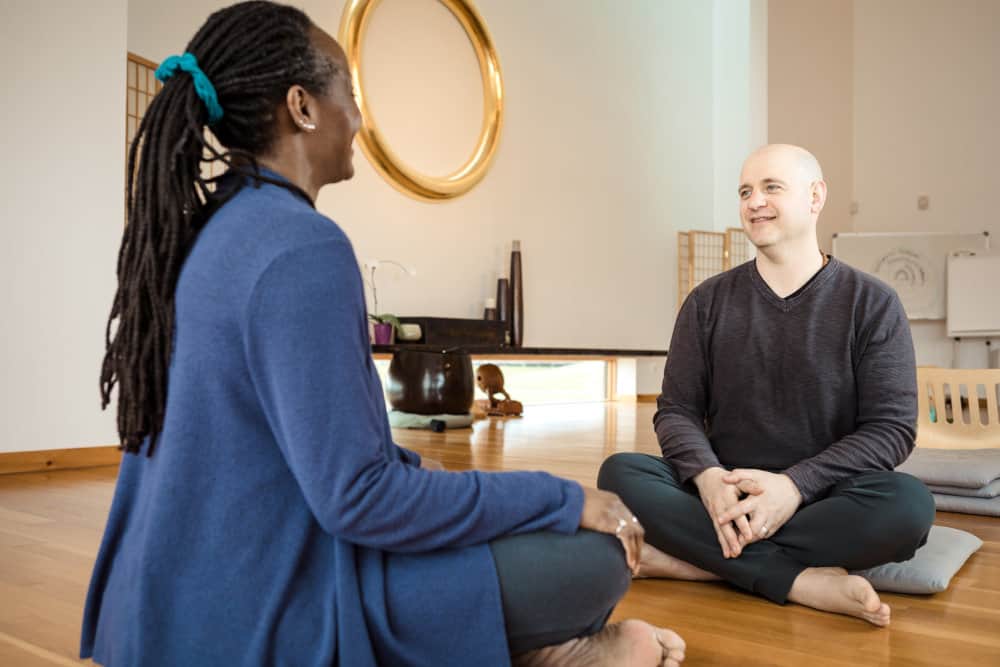
Yoga offers cancer patients and survivors a holistic approach to healing their bodies and minds. Not only can yoga help with the physical and mental effects of having cancer, but also the effects of treating cancer and helping clients regain agency over their bodies. If you’re interested in using yoga to help cancer patients and survivors heal, it’s critical to complete the right yoga for cancer training so you’re prepared to work safely and effectively with clients.
As an experienced yoga therapist and the lead teacher of my own yoga therapy program, my mission is to make yoga more accessible to others. Below, I’ll share my knowledge about the benefits of yoga therapy for cancer patients and survivors, how to use yoga with these clients, yoga cancer training, and more to help you on your journey. If you’d like to apply to our program, you can learn more and apply here.
Table of Contents:
There are numerous benefits to using yoga therapy for cancer patients and survivors. Yoga can help improve physical, mental, emotional, and spiritual health, tackling health conditions and side effects at every stage of these clients’ journeys.

The lymphatic system is a network of vessels and organs that carry lymph, a clear fluid that helps fight infection and disease, throughout the body. Cancer treatment can damage the lymphatic system, leading to lymphedema, a condition where excess lymph fluid accumulates in the soft body tissues, causing swelling and inflammation. This is especially common among breast cancer patients, where the generally accepted incidence rate is around 30%, as noted by the Journal of Clinical Oncology.
Yoga therapy can be a valuable tool in stimulating the lymphatic system and keeping lymph fluids moving, which can help with overall health. The lymphatic system is also a key component of the immune system, and improving lymphatic circulation can help the body better fight off infection and disease. Additionally, stimulating the lymphatic system can help the body eliminate toxins and waste products, further supporting overall health and wellness.
Certain standing poses and inversions can help promote lymph flow, though you should take care to modify them appropriately for cancer patients and survivors. This can reduce the risk of injury while still achieving the same benefits. Examples include:
Learning how to appropriately modify poses is a major component of yoga for cancer training.
Studies have shown that yoga can lessen side effects caused by cancer treatments, such as radiation, chemotherapy, and medication. One study found that yoga reduced cancer patients’ anxiety, depression, and fatigue while improving emotional health.
In my experience, this is often the biggest benefit of yoga therapy for cancer patients, and something we always cover in our own yoga cancer training lessons. Cancer medication can have a significant impact on patients’ quality of life due to the side effects it produces.
Yoga therapy can help combat fatigue and lack of sleep, improve strength and flexibility, and give cancer patients techniques for dealing with anxiety and brain fog. It doesn’t eliminate the side effects of cancer treatment, but it can reduce them and provide better outcomes.
A complication is a health condition that occurs during or after another health condition or its treatment. By contrast, comorbidity is a pre-existing condition that coexists with another health condition and may affect its treatment. It is not uncommon for cancer patients to deal with complications and comorbidities. For example:
Yoga therapy has been shown to be an effective complementary treatment for managing complications and comorbidities that often arise during cancer treatment and recovery. By promoting relaxation, reducing stress and inflammation, and increasing physical and emotional well-being, yoga therapy can help improve quality of life and overall health outcomes.

Many cancer patients and survivors face anxiety, depression, and other mental health conditions. Yoga therapy can be a powerful tool to help address these issues and improve mental health, with a proven track record of reducing anxiety among cancer patients with a range of diagnoses. A yoga therapist who has received yoga for cancer training can equip patients and survivors with tools for staying in the present and eventually help retrain the brain and nervous system.
Cancer patients and survivors often experience trauma related to their illness, treatment, and overall experience. Trauma can manifest in various ways, such as anxiety, depression, and post-traumatic stress disorder (PTSD), which can have a significant impact on their mental and emotional well-being. Yoga therapy can help treat trauma in cancer patients and survivors, providing them with a holistic approach to healing:
Trauma-informed yoga therapy is designed to center the client’s autonomy over their own body. A knowledgeable yoga therapist should use invitational language, rather than directives, with cancer patients and survivors, along with other trauma-informed techniques.
Yoga therapy can help cancer patients and survivors reconnect with their bodies, which can be especially important for those who have undergone invasive medical procedures. Many cancer patients and survivors feel disconnected from their bodies and benefit from feeling agency over their own health and body again. Practices such as body scans, gentle movement, and meditation can help clients become more aware of their body and its sensations, promoting a sense of control and empowerment.
The best way to help cancer patients and survivors with yoga is to become a yoga therapist and receive yoga for cancer training. A doctor’s scope is limited to treating the cancer, often leaving patients to cope with any consequences that don’t directly impact their cancer on their own. Yoga therapy training will teach you how to work with individuals in a variety of ways—not only with the cancer itself, but all the other things that might be related to a client’s cancer and negatively affecting them.
If you’re looking for a fulfilling career path that involves helping others, consider becoming a yoga therapist. As a yoga therapist, you can provide cancer patients and survivors with a holistic practice that helps improve physical, mental, emotional, and spiritual health. Yoga is a safe, effective, and low-cost modality that can add considerable value to any cancer care, with demand continually growing among patients.
Whether you’re already an occupational therapist, physical therapist, massage therapist, mental health professional, or other healthcare practitioner looking to add yoga to your repertoire or you come from outside the medical field, yoga therapy training can equip you with the skills you seek and put you on a rewarding career path.

Choosing the right yoga cancer training program is crucial for anyone wishing to support cancer patients and survivors in their journey towards healing. Inadequate training can result in ineffective support for your clients or even injury or harm. To find the best yoga for cancer patients training program, consider the following:
Some yoga therapy programs like Breathing Deeply’s include a yoga for cancer training component in addition to the other topics needed to become a yoga therapist. There are also more specialized trainings that focus exclusively on using yoga for cancer, although these tend to be most beneficial if you decide to seek even deeper cancer training after completing a foundational yoga therapy program.
You should only use yoga with cancer patients and survivors if you have been trained how to do so. If you make the decision to complete yoga therapy training, keep these objectives in mind to make sure you are adequately prepared to start working with cancer patients and survivors.
Yoga therapy should always be personalized to the client at hand, taking into account their unique circumstances, health, abilities, and goals. Understand the common symptoms, side effects, and limitations that cancer patients and survivors may be facing, and be prepared to adapt to your client.
When thinking about how to plan yoga therapy for these clients, most cancer patients and survivors can benefit from the following as a starting point:

At its root, anxiety is fear of the future or what could happen. For those who have cancer, it’s normal for there to be anxiety about their diagnosis, treatment, and prognosis. Even when someone is recovering from cancer, they may be periodically checked months and even years into the future to see if their cancer has come back, which can be a source of anxiety for many cancer survivors. Therefore, it is especially important to teach these clients to stay in the present. This can include:
In particular, pranayama and chanting can act as good preparatory practices to help the mind stay in the present before meditating. Regular practice of these and other present-centered focus techniques can help train the brain to be in the present.
Combining gentle asanas and breath work can be especially beneficial for training a client’s nervous system response to aid in present-centered thinking, as can yoga nidra and other constructive rest practices. The parasympathetic nervous system promotes rest and digestion, as opposed to the fight-or-flight response of the sympathetic nervous system, which is why learning to regulate the nervous system is so important for cancer patients and survivors.
If you plan to specialize in cancer care, it will be helpful to learn about different cancers, treatments, and medications so you can work effectively with a range of clients. If you are just trying to prepare to help a specific client who has cancer or had cancer, you can focus your efforts on researching their specific cancer, treatments, and medications.
For instance, breast cancer patients are more likely to need more focus on the lymphatic system and movement, while lung cancer patients and clients undergoing chemotherapy might involve more anti-anxiety techniques and gentle breath work. Clients who are experiencing joint pain and bone loss from chemo should avoid spending extended time on their hands and knees, as their vertebrates have likely become very delicate and prone to damage, while those with lymphedema may find weight-bearing exercises frustrating and painful but still potentially benefit from them.
In addition to completing yoga cancer training and doing your own research and precautions, you will always need to get clearance from a cancer patient’s doctor to do any yoga with you.
When working with cancer patients and survivors, it is important to avoid any contraindications to ensure their safety and well-being. These will vary from person to person, depending on their cancer and treatment. Yoga therapy programs like Breathing Deeply’s include yoga for cancer training components that cover some of the contraindications that you’re likely to see with these clients.
A few common contraindications include:
Always communicate with the client and their medical team to ensure that the yoga practice you recommend is appropriate and safe. As mentioned above, you will also need to get approval from their doctor before they can practice any yoga with you. Remember that each person’s needs and abilities may vary, so modifications and adjustments are often necessary.
Effective communication is crucial when working with people affected by cancer. Clear and empathetic communication can help build trust, reduce anxiety, and improve the overall healing process. Learning how to work with people who are going through major medical events involves not only how you should and should not use yoga to help them, but also how you should talk to someone going through something difficult.
To improve communication, it is important to actively listen to your client, using appropriate language, and acknowledging their emotions:
Having strong communication skills can allow your clients to feel more comfortable and supported on their healing journey.

Are you interested in becoming a yoga therapist? Do you want to help people facing cancer and a host of other physical and mental health issues?
At Breathing Deeply, we offer yoga therapy training programs for students at every skill level, from those just starting out to those who are ready for advanced training. We provide several days of training devoted specifically to cancer care taught by Meena Ananth, a registered nurse and yoga therapist with over 15 years of experience working in the field of nursing and oncology.
Our students can get started for just $500 down and pay as they go, providing flexible pacing for both coursework and payments. Become a yoga therapist in as little as one year or take as long as you need.
Apply to our yoga therapy school today or contact us with any questions you may have. We look forward to hearing from you!
Brandt talks about common questions applicants have about the Breathing Deeply Yoga Therapy Program. Tune in to get the full program details.
Friends in Yoga, The way we perceive the world is a curious thing. Is it on fire or getting better? Are we facing our challenges or shying away from them? Are we functioning from the present or some altered reality based on past experiences? The teachings tell us that reality is ultimately timeless. The vibration […]
There’s no doubt that yoga is gaining popularity, but you may be asking yourself, what is the most popular type of yoga? Where is each type most popular in the U.S. and around the world? And for those who are interested in trying it themselves, how can you practice these styles of yoga safely? For […]
Friends in Yoga, Sitting on a cushion, taking a yoga class, chanting a mantra before your morning coffee…no one would call these radical acts. They are small choices that we make to better ourselves. The motivation to practice often takes form by our desire to be healthier, to be more focused, to connect with our […]